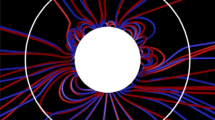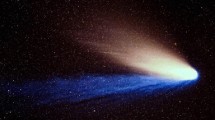Abstract
This paper presents a continued study of the two-dimensional guiding-center model of the solar wind interaction with the Moon. The characteristics theory and the computational method are discussed. The magnetic permeability of plasma is (1 + β/2)−1 in the solar wind flow upstream of the Moon, and it changes to 1 in the void region of the lunar wake. The gradual change of the magnetic permeability in the penumbral region from the interplanetary condition to the void condition is explained as the source of field perturbations in the lunar wake. Perturbations of the magnetic field propagate as magnetoacoustic waves in a frame of reference moving with the plasma flow. Computer solutions were obtained to show that (i) the two principal perturbations of the magnetic field in the lunar wake (the umbral increase and the penumbral decrease) are confined to a region bounded by a Mach cone tangent to the lunar body, and (ii) the penumbral increases occur outside the lunar Mach cone. Computer solutions are also used to identify the source of field perturbations and to simulate the solar wind-moon interaction under varying interplanetary conditions.
Similar content being viewed by others
References
Colburn, D. S., Currie, R. G., Mihalov, J. D., and Sonett, C. P.: 1967, ‘Diamagnetic Solar-Wind Cavity Discovered behind Moon’, Science 158, 1040.
Johnson, F. S. and Midgley, J. E.: 1968, ‘Notes on the Lunar Magnetosphere’, J. Geophys. Res. 73, 1523.
Lyon, E. F., Bridge, H. S., and Binsack, J. H.: 1967, ‘Explorer 35 Plasma Measurements in the Vicinity of the Moon’, J. Geophys. Res. 72, 6113.
Michel, F. C.: 1968, ‘Magnetic Field Structure behind the Moon’, J. Geophys. Res. 73, 1533.
Ness, N. F., Behannon, K. W., Scearce, C. W., and Cantarano, S. C.: 1967, ‘Early Results from the Magnetic Field Experiment on Lunar Explorer 35’, J. Geophys. Res. 72, 5769.
Ness, N. F., Behannon, K. W., Taylor, H. E., and Whang, Y. C.: 1968, ‘Perturbations of the Interplanetary Magnetic Field by the Lunar Wake’, J. Geophys. Res. 73, 3421.
Ogilvie, K. W. and Ness, N. F.: 1969, ‘Dependence of the Lunar Wake on Solar Wind Plasma Characteristics’, J. Geophys. Res. 74, 4122.
Siscoe, G. L., Lyon, E. F., Binsack, J. H., and Bridge, H. S.: 1969, ‘Experimental Evidence for a Detached Lunar Compression Wave’, J. Geophys. Res. 74, 59.
Spreiter, J. R., Marsh, M. C., and Summer, A. L.: 1970, ‘Hydromagnetic Aspects of Solar Wind Flow past the Moon’, Cosm. Electrodynamics 1, 5.
Taylor, H. E., Behannon, K. W., and Ness, N. F.: 1968, ‘Measurements of the Perturbed-Interplanetary Magnetic Field in the Lunar Wake’, J. Geophys. Res. 73, 6723.
Whang, Y. C.: 1968, ‘Interaction of the Magnetized Solar Wind with the Moon’, Phys. Fluids 11, 960.
Whang, Y. C.: 1969, ‘Field and Plasma in the Lunar Wake’, Phys. Rev. 186, 143.
Whang, Y. C. and Ness, N. F.: 1970, ‘Observations and Interpretation of the Lunar Mach Cone’, J. Geophys. Res. 74
Wolf, R. A.: 1968, ‘Solar-Wind Flow behind the Moon’, J. Geophys. Res. 73, 4281.
Author information
Authors and Affiliations
Rights and permissions
About this article
Cite this article
Whang, Y.C. Two-dimensional guiding-center model of the solar wind-moon interaction. Sol Phys 14, 489–502 (1970). https://doi.org/10.1007/BF00221333
Received:
Issue Date:
DOI: https://doi.org/10.1007/BF00221333




